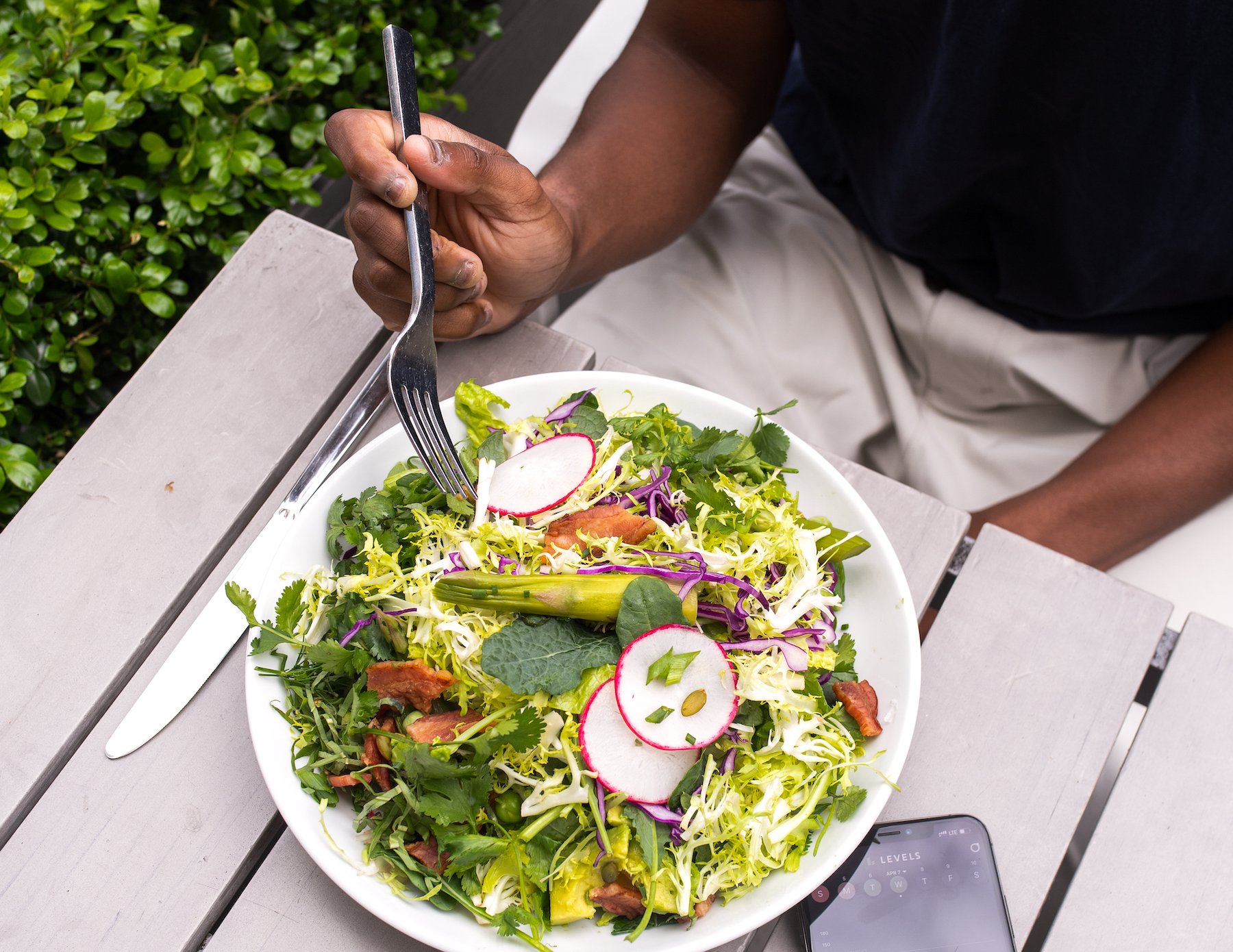Most of us have habits that we would like to improve when it comes to health and nutrition—get more sleep, eat less sugar, drink more water. So what gets in the way? As a dietitian, the most common obstacle that I see people face when it comes to behavior change is a lack of clarity around goal setting: we can see the target, but we’re not quite sure how to get there.
How do we change that? In my years of practice, I’ve seen many clients successfully identify and reach health goals beyond what they initially believed possible. While not an exact science, there are common themes that run through each success story. The key is to break large goals up into smaller milestones that you can progressively master, building self-confidence along the way.
Good information is paramount; the more you know, the better. Biological observability is the process of gathering data about how your body responds to food, sleep, and exercise patterns, and using that data to make informed decisions about your health. The library of available instruments to gather such data is growing increasingly large and advanced.
A continuous glucose monitor (CGM), which provides immediate information about blood sugar levels, is one tool that you can use to deepen your understanding of how lifestyle factors impact your metabolic health. Understanding the psychology of behavior change and coupling that with insights gleaned from biological observability tools, will equip you to tackle any health goal with confidence.
Getting Started
The Transtheoretical Model of Behavior Change (also known as the Stages of Change Model) is a valuable framework to help you understand where you stand in the goal-setting process. It describes six stages in the process of behavior change: precontemplation, contemplation, preparation, action, maintenance, and termination:
- Precontemplation: In this stage, the person is not planning on making a change. They may be unaware of the consequences of their actions, or feel that their goals are unattainable (e.g. “Nothing I do seems to work, the weight just won’t budge.”).
- Contemplation: Here, the person considers making a change. This may come from new information or increased frustration with the problem. However, they aren’t quite ready to do so. The defining characteristic of the contemplation stage is ambivalence, or mixed feelings; although they begin to see the possibility and benefits of change, they are daunted by the process or the costs (such as preparing more meals at home to limit processed convenience foods, fitting a workout into their busy schedule, or eating fewer sweets).
- Preparation: At this point, the person prepares to make a change. They might obtain a CGM to monitor their blood sugar, talk to their happy hour group about an alternative after-work activity, or clear out their pantry of high-sugar foods.
- Action: Now, the person begins taking direct action to achieve their goals. They begin to actively log meals, walk around the block after dinner, and find substitutes for high-carb foods such as pasta and sandwiches.
- Maintenance: In the final stage, the person has achieved success through their actions and continues their healthy behaviors to sustain this success.
- Termination: The termination stage refers to a point at which the person reaches 100% confidence that they have no chance of returning to their old habits. As this is usually unrealistic, this stage is often omitted from discussion.
Recognizing your stage in the context of this model can help you take the appropriate actions to move forward if you’re stuck in pursuit of your goal. For many people I work with, clearly identifying the value that behavior change could bring to their life provides the boost they need to move from the contemplation into the preparation stage. One of my favorite success stories is from a client who was finally able to change her diet after she realized that her primary motivation was not to fit into her favorite jeans, but to have enough energy to play with her preschool-aged children.
This doesn’t mean that it gets easy: preparation is one of the most difficult stages, as you must find the unique strategies that will work for you. This is where bio-observability is key; if your goal is to ease menopause symptoms, for example, and you see that your overnight hot flashes are worse when you eat a carb-heavy dinner, you might switch the majority of your carb intake to the morning when the body is generally more insulin sensitive. Once you’ve created your action plan, you can boost your chances of success both in the short and long-term (maintenance stage) by creating environmental conditions that are favorable to your endeavors, such as supportive friends and family, healthy snacks at work, and a safe, stress-free space to exercise.
Setting Achievable Goals
How do you make sure that your goals are achievable? One strategy is to make sure that they’re SMART: specific, measurable, attainable, relevant, and time-bound. If my client’s ultimate aim is to shed 40 lbs by the end of the year, I might advise that they set a smaller weight loss target of 1 lb/week. Their specific action steps could be to swap their oatmeal in the morning for a green smoothie with protein powder or a veggie-packed crustless quiche, walk for 30 minutes after lunch 4 days a week, and limit dessert after dinner to the weekends. Breaking down your goals like this allows you to take concrete steps to meet them.
It’s helpful to frame goals as approach-oriented rather than avoidance-oriented. Approach-oriented goals focus on actions and positive outcomes, which can improve your motivation: “If I eat a protein-packed breakfast to keep my blood sugar steady, I’ll have more energy to get through my workday.” Avoidance-oriented goals are centered around preventing negative outcomes: “If I don’t lose weight, there’s a greater chance that I’ll develop cardiovascular disease.” Those who set approach-oriented goals have been shown to be more successful; one study that examined New Year’s Resolutions found that 58.9% of participants who set approach-oriented goals considered themselves successful at one-year follow-up vs. 47.1% who set avoidance-oriented goals, a significant difference.
Finally, remember to select action strategies that you’re excited about. Many of my clients come to me thinking that getting healthier has to be a chore, but it doesn’t. If you hate running, don’t make that your primary exercise. If you know that you’re social, enlist friends to cook healthy meals together. You’re more likely to engage in and maintain behaviors that you enjoy, so set yourself up for success by capitalizing on the things that make you happy.
Building Self-Efficacy
Setting and reaching milestones builds your self-efficacy, or belief in your ability to accomplish the things you set out to do. This motivates you to continue engaging in your healthy behaviors. High self-efficacy also protects you from the effects of setbacks; for example, if you fail to snooze your alarm in time for your morning workout on Friday but you know that you did it successfully every other day of the week, you’re more likely to remain confident that you can get up in time on Saturday.
Biological observability tools such as CGM’s can bolster self-efficacy by providing you with real-time data that confirms your success. We often feel a sense of accomplishment when we make a healthy choice, such as choosing a piece of high-fiber fruit instead of cake for dessert. Seeing the numbers reflect that win (e.g. a smaller glucose spike) can boost that feeling further, reinforcing our actions and making it more likely that we’ll choose the healthy option in the future. Research has shown that use of health apps can increase reported goal achievement rates, particularly in users who report initial low self-efficacy.
Sustaining the Change
We often set new goals on or after a specific event (e.g. birthday, New Year’s Day, the beginning of a new week or month)—this phenomenon has been deemed “the fresh start effect.” It often gets harder to sustain motivation the farther away we get from that timestamp.
There are several strategies you can use to keep the momentum going when you hit a lull. One tactic is to leverage dopamine, a neurotransmitter in the brain that is closely linked to motivation. When dopamine is elevated, you are more likely to focus on and pursue your goals. You can ensure that you maintain healthy base dopamine levels through lifestyle factors such as moderating caffeine use and getting early morning sunlight. Selectively rewarding your effort with a healthy treat (such as a massage after five completed workouts or a nice dinner out after two weeks of home-cooked meals) will lead to a dopamine release, keeping you motivated to continue. Try to refrain from using hyper-palatable foods (high in salt, sugar, and/or fat) as rewards, as this will activate the brain’s reward circuitry in a way that can further drive cravings.
You could also leverage the cognitive bias we tend to possess where we remember the most intense moment and the conclusion of an experience more vividly than the middle part. This phenomenon is referred to as the peak-end rule. If you’re doing a particularly demanding workout, such as high-intensity interval training (HIIT), you could choose to end with an extended rest period. This increases the chances that your brain will associate the workout with the restorative feeling that you felt at its conclusion, thus making you more willing to lace up your sneakers next time.
Continuing to Adapt and Evolve
There is a psychological phenomenon known as the end-of-history illusion, which describes how people often feel that they have changed substantially in the past but will change relatively little in the future. We often assume that our preferences are fixed when in fact we are dynamic entities, constantly adapting and evolving. As you continue to work towards your goals, be mindful of your response to food and exercise, and maintain room for flexibility and experimentation. Your taste preferences may shift over time; for example, adopting a high-fiber, low-sugar diet has been shown to reduce cravings naturally. It’s important to audit yourself throughout the change process so that you make sure that you’re using the most effective strategies for your current condition (who knows, maybe with the increased energy that you get from stable glucose levels, you may learn to love running!). Leveraging biological observability and behavior change theory to deepen your understanding of your body and your mind will help you to set and meet health goals at any stage of life.
 Ready to see how Levels can help you reach your goals?
Ready to see how Levels can help you reach your goals?
Start taking action today to optimize your metabolic health so you can feel better and live a longer, healthier life. Levels members get access to the most advanced continuous glucose monitors (CGM), along with an app that offers personalized guidance so you can build healthy, sustainable habits. Click here to learn more about Levels.









